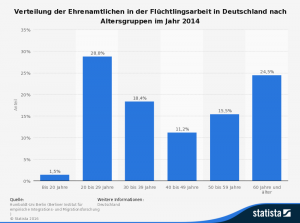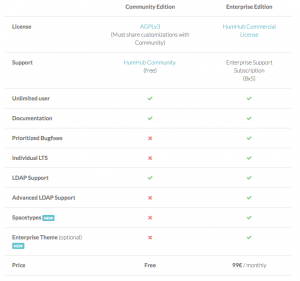The background
Locally organized voluntary groups, helping refugees manage their first steps in Germany, are often organized by mass-email with up to 50 recipients. So the huge amount of received emails which should be clarified ends up in a “answer all”-flood of every involved mailbox. Another realistic misbehaviour is that images are sent uncompressed as attachment, so some recipient mailbox exceed their limitation of 25MB per mail.
The chart above shows the composition of such local social groups, categorized by age. So the majority of the members are in the age of 20-29 or 60+. This illustrates the gap of the 30-60 year old people. The latest technology, the 60+ people know about, is email or the widest spread messenger Whatsapp. They never got in touch with a tool for project management, task scheduling, collaborative working etc.. This doesn’t mean they’re unable to use these tools, but simply nobody suggests them to do so.
In the local group, being our trigger for this project, the average age of responsible people is 50+. Many of them are working at their full-time job in parallel. They don’t have time to care about new communication technologies, and anyway their matter of heart is to help people!
Lets enhance!
So we decided to change this grievance by searching different possibilities for group conversation, in respect to the target user group. First we thought about developing our own volunteer-platform with user centered functionality and a nice interface. But after some time of conceptual planning, we started searching for existing tools for our purpose. The buzzword is “open source social network”… and there are a lot of them. Spoken simplified, all of them provide a platform with user profiles, messaging, posts and groups. We decided, that for our purpose the usability is the most important decision criterion.
And the winner is..
HumHub is an flexible Open Source Social Network Kit with modular features and a clean UI (https://www.humhub.org/en). The platform is fully-responsive and independent from your browser version. Go and check it out on your own, but come back to continue reading this blog post!
Due to the Open Source Community, the available modules are of a gorgeous variation. Just to name a few, Calendar, DropboxAPI, Mail, Meetings, SMS-Gateway and many more are available on the fly. The given functionality is really close to facebook’s.
While the personal version of HumHub is for free, the “Enterprise Edition” costs 99€/month with special support and prior bug fixes. While HumHub is licenced under AGPL V3 (https://www.humhub.org/de/licences) the software is free to reuse under the condition to publish all of the changes in sourcecode under AGPL V3, too. This is confirmed by a mail conversation with an interested and helpful employee of HumHub GmbH & Co. KG.
HumHub GmbH & Co. KG as the company behind HumHub is also offering a cloud-based service of it’s product. This academic test-project has never been intended to compete with this service on the market, but to get in touch with cloud-computing technology in a real-world project.
Humhub goes social
Humhub itself is organized in groups and spaces. “Groups” are used for the organizational structure and have no impact to the user’s rendered frontend. On the other hand “spaces” are like “groups in facebook”, which can be declared as private, secret or open. For the sake of real-time-interaction the system offers different type of email-notifications, like an instant message or a daily sum-up.
For the purpose of the local volunteer groups it is obvious to use the “spaces” in Humhub for the different internal groups like “clothing distribution” or “shuttle service”. In there, it is possible to arrange appointments, share news and informations or easily ask for a replacement regarding the tuesday shift in the “uniform store”. The challenging part will be to convince all of the local members about the benefits of this system as communication platform.
Local Field Test
In parallel to our cloud-based developments (see the following blog posts) we started using a single-instance beta test of Humhub in a local voluntary group. It was nice to see, that the different aged members are willing to learn about these kind of interactions. The created groups are: Administration, HumHubSupport, Internet, General Informations, Shuttle Service and Clothing Store. Besides some struggle with the segmentation of personal messages and public posts the first weeks of using Humhub in the local group has been really successful. Sadly a little remaining group of persons still use group-emails for urgent informations, instead of the platform. But we hope we could make the mass-mail world of social volunteer groups even a bit better.
So in the next episode of our series, we like to dive in more technically again, and have a closer look at the IBM-Bluemix architecture and how we could use the services to reach our vision of a cloud-based social network.
Written by Natali Bopp, Andreas Gold, Jonas Häfele, Merle Hiort, Martin Kopp, Christian Lang, Anna Poth und Eric Weislogel






Leave a Reply
You must be logged in to post a comment.